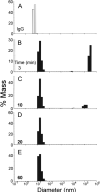A synthetic trivalent hapten that aggregates anti-2,4-DNP IgG into bicyclic trimers
- PMID: 17326636
- PMCID: PMC2535943
- DOI: 10.1021/ja067159h
A synthetic trivalent hapten that aggregates anti-2,4-DNP IgG into bicyclic trimers
Abstract
This paper describes the synthesis of the trivalent hapten molecule 1, containing three 2,4-dinitrophenyl (2,4-DNP) groups, and the use of this molecule to aggregate three molecules of anti-2,4-DNP IgG into a complex with 3:2 stoichiometry (IgG312). The equilibrium product IgG312 was generated in approximately 90% yield upon mixing IgG and 1; during incubation, thermodynamically unstable, high-molecular-weight aggregates (>104 nm in diameter) form first and convert subsequently to IgG312. The thermodynamics and the kinetics of the formation of aggregates were studied using size-exclusion high-performance liquid chromatography (SE-HPLC), dynamic light scattering (DLS), and analytical ultracentrifugation (AUC). An analytical model based on multiple species in equilibrium was developed and used to interpret the SE-HPLC data. The aggregate IgG312 was more stable thermodynamically and kinetically than monomeric aggregates of this IgG with monomeric derivatives of 2,4-DNP; this stability suggests potential applications of these aggregates in biotechnology.
Figures







References
-
- Mammen M, Choi SK, Whitesides GM. Angew. Chem.-Int. Edit. 1998;37(20):2755–2794. - PubMed
-
- Yang J, Mayer M, Kriebel JK, Garstecki P, Whitesides GM. Angew. Chem.-Int. Edit. 2004;43(12):1555–1558. - PubMed
-
- Rao JH, Lahiri J, Weis RM, Whitesides GM. J. Am. Chem. Soc. 2000;122(12):2698–2710.
-
- Rao JH, Lahiri J, Isaacs L, Weis RM, Whitesides GM. Science. 1998;280(5364):708–711. - PubMed
-
- Rao JH, Whitesides GM. J. Am. Chem. Soc. 1997;119(43):10286–10290.
Publication types
MeSH terms
Substances
Grants and funding
LinkOut - more resources
Full Text Sources
Other Literature Sources

